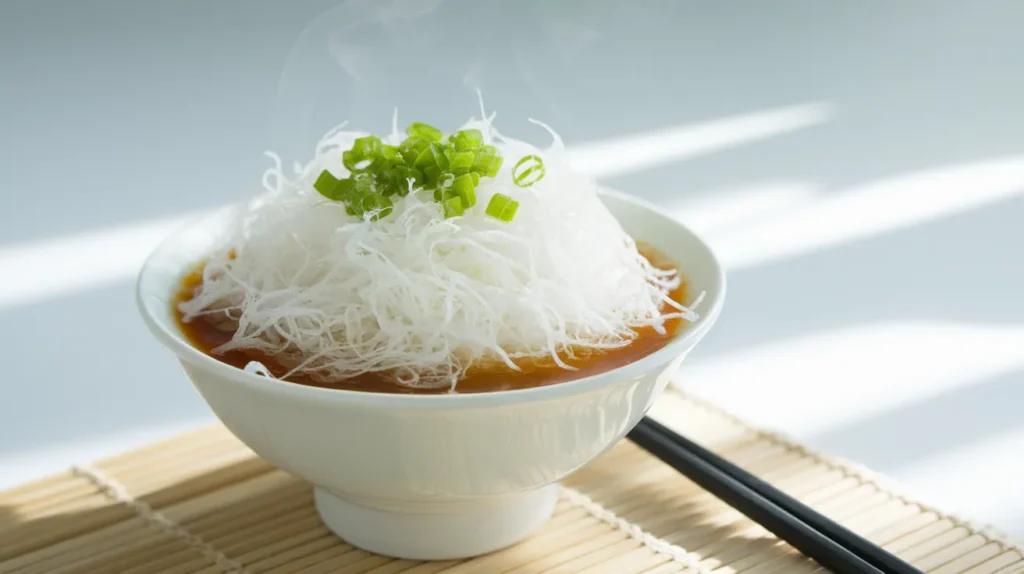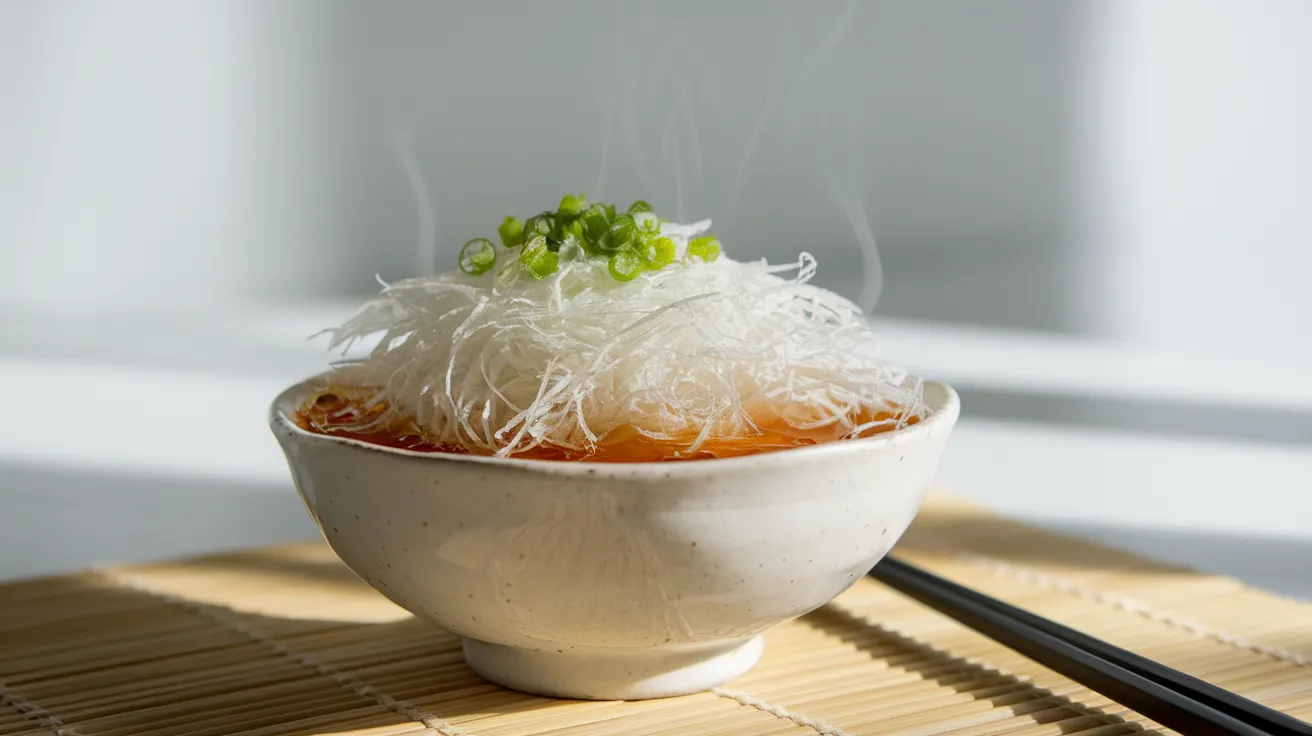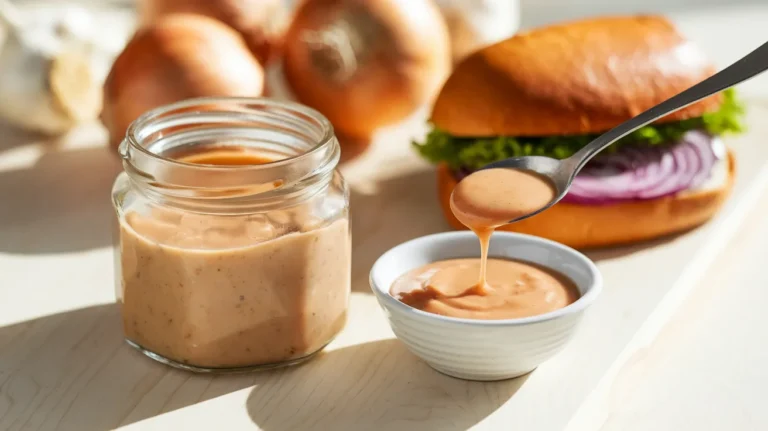This authentic oroshi sauce combines the clean, sharp bite of freshly grated daikon radish with savory seasonings to create Japan’s most beloved condiment. Perfect for tempura, grilled fish, or any dish needing a refreshing kick, this oroshi sauce recipe delivers restaurant-quality results at home with just a few simple ingredients.
SERVES: 4 | PREP: 15 MIN | COOK: 0 MIN | TOTAL: 15 MIN
Ingredients for Oroshi Sauce
Fresh Components
| Ingredient | Amount | Notes |
|---|---|---|
| Fresh daikon radish | 1 medium (about 8 inches) | Must be fresh and firm |
| Fresh ginger | 1-inch piece | Optional but recommended |
| Green onions | 2 stalks | For garnish |
Sauce Base
| Ingredient | Amount | Purpose |
|---|---|---|
| Soy sauce | 3 tablespoons | Adds umami depth |
| Rice vinegar | 2 tablespoons | Balances flavors |
| Mirin | 1 tablespoon | Subtle sweetness |
| Dashi powder | 1/2 teaspoon | Enhances savory notes |
Step-by-Step Oroshi Sauce Instructions
Phase 1: Daikon Preparation (5 minutes)
Step 1: Wash the daikon radish thoroughly under cold running water. Pat completely dry with paper towels. Why this matters: Any moisture will dilute your oroshi sauce and affect the texture.
Step 2: Peel the daikon using a vegetable peeler, removing about 1/8 inch of skin. Look for: Bright white flesh underneath – this indicates freshness.
Step 3: Cut the daikon into manageable 3-inch sections. Safety tip: Smaller pieces are easier to control when grating and reduce hand fatigue.
Phase 2: Grating Process (8 minutes)
Step 4: Using a fine-mesh grater or oroshigane (traditional Japanese grater), grate the daikon in circular motions. Technique tip: Apply gentle, consistent pressure – let the grater do the work.
Step 5: Grate directly over a fine-mesh strainer placed over a bowl. Why: This catches the liquid (daikon juice) separately, which you’ll use for the sauce base.
Step 6: Continue grating until you have approximately 1 cup of grated daikon. Visual cue: The texture should resemble fluffy snow with some juice naturally separating.
Step 7: Gently press the grated daikon with the back of a spoon to extract additional juice. Don’t over-press – you want some moisture remaining in the daikon.
Phase 3: Sauce Assembly (2 minutes)
Step 8: In a small mixing bowl, combine the collected daikon juice with soy sauce, rice vinegar, and mirin. Measurement tip: Start with less liquid and adjust to taste.
Step 9: Whisk in the dashi powder until completely dissolved. Visual check: No granules should be visible in the liquid.
Step 10: If using ginger, grate it finely and add 1/2 teaspoon to the sauce mixture. Taste test: Add gradually – ginger can overpower the delicate daikon flavor.
Step 11: Gently fold the grated daikon back into the seasoned liquid. Folding technique: Use a spoon to lift and turn, preserving the fluffy texture.
Step 12: Finely chop green onions and sprinkle on top as garnish. Serving tip: Add green onions just before serving to maintain color and crunch.
Chef’s Notes for Perfect Oroshi Sauce
Fresh is Everything: The key to exceptional oroshi sauce lies in using the freshest daikon possible. Look for radishes that feel heavy for their size with smooth, unblemished skin.
Grating Technique: Traditional Japanese cooks use a copper oroshigane, but a microplane or fine box grater works excellently for home preparation.
Liquid Balance: Save that precious daikon juice! It contains concentrated flavor and natural enzymes that make your oroshi sauce truly authentic.
Serving Temperature: This oroshi sauce tastes best when served at room temperature or slightly chilled, allowing the daikon’s natural sweetness to shine through.
Nutrition Information (Per Serving)
- Calories: 25
- Protein: 1g
- Carbohydrates: 6g
- Fat: 0g
- Fiber: 2g
- Sodium: 580mg
Creative Oroshi Sauce Variations
Spicy Oroshi: Add 1/2 teaspoon of shichimi togarashi (Japanese seven spice) for heat and complexity.
Citrus Oroshi: Replace rice vinegar with fresh yuzu or lemon juice for a brighter, more acidic profile that pairs beautifully with katsu curry sauce dishes.
Umami-Rich Version: Double the dashi powder and add 1 teaspoon of bonito flakes for deeper ocean flavors.
Restaurant-Style Oroshi: Incorporate 1 tablespoon of savory dashi sauce for professional-level depth and complexity.
Storage & Reheating Guidelines
Immediate Use: Oroshi sauce tastes best within 2 hours of preparation when the daikon retains its crisp texture and bright flavor.
Refrigeration: Store covered in the refrigerator for up to 24 hours. Note: The daikon will soften and release more liquid over time.
Texture Changes: After storage, gently stir to redistribute separated liquids before serving.
Make-Ahead Tip: Prepare the sauce base up to 3 days in advance, but grate the daikon fresh for optimal texture and taste.

Troubleshooting Common Oroshi Sauce Issues
Problem 1 – Watery Consistency Solution: Drain excess liquid and add more freshly grated daikon. The daikon should be moist but not swimming in juice.
Problem 2 – Too Salty or Strong Solution: Dilute with additional daikon juice or a splash of water. Balance with a pinch of sugar if needed.
Problem 3 – Bitter Aftertaste Solution: This usually indicates old daikon. Use the freshest radish possible and avoid the core if it appears woody.
Problem 4 – Lost Texture After Storage Solution: Mix in some freshly grated daikon to restore the signature fluffy consistency.
Problem 5 – Lack of Flavor Depth Solution: Increase dashi powder gradually or add a few drops of sesame oil for richness without overpowering the delicate daikon.
Equipment Essentials
Primary Tools:
- Fine-mesh grater or microplane
- Fine-mesh strainer
- Small mixing bowls
- Sharp vegetable peeler
Alternative Options:
- Food processor with grating disc (for large batches)
- Traditional Japanese oroshigane (authentic texture)
- Box grater (fine side only)
Shopping List by Store Section
Produce Section:
- 1 medium fresh daikon radish
- 1-inch piece fresh ginger
- 2 green onions
Asian Foods Aisle:
- Soy sauce
- Rice vinegar
- Mirin
- Dashi powder
Pantry Staples:
- None needed beyond above items
Success Secrets for Restaurant-Quality Oroshi Sauce
1. Choose daikon that’s firm and heavy with smooth skin – avoid any with soft spots or yellowing.
2. Grate in one direction only to maintain the daikon’s natural fiber structure and prevent mushiness.
3. Taste and adjust seasonings gradually – the daikon’s natural sweetness varies by season and variety.
4. Serve immediately after preparation when possible for the brightest flavor and best texture.
5. Keep your grater clean and sharp – dull blades create paste instead of the desired fluffy texture that makes oroshi sauce special.




